Oakmoss is perfumery's crown jewel, prized for its rich, earthy profile of over 80 distinct compounds. You'll find this complex note enhances and stabilizes your natural perfume blends while adding depth through its mossy, woodsy, and leathery facets. Master its use by starting with small amounts and pairing it with citrus, florals, or woods. While strict IFRA guidelines limit its concentration to 0.1%, understanding proper dilution techniques will reveal oakmoss's full potential in your creations.
The Origins and History of Oakmoss in Perfumery

While many natural ingredients have come and gone in perfumery's long history, oakmoss has maintained its prestigious status for thousands of years.
You'll find evidence of its significance in ancient Egyptian royal tombs, where it was discovered alongside myrrh and pine resin in burial baskets.
The Egyptians prized it not only for its fragrance but also for its antiseptic properties during mummification.
Today, this timeless ingredient continues its legacy as a delicately woody aroma that bridges classical and contemporary perfumery.
Understanding Oakmoss Extraction Methods
The ancient Egyptians' reverence for oakmoss has evolved into modern scientific extraction methods that maximize its aromatic potential.
You'll find that today's extraction process begins with careful humidification of the lichen to restore cell wall permeability, followed by a three-stage lixiviation process using various solvents. The resulting extract requires only small quantities for significant impact, making it highly efficient for perfumery applications.
While ethanol yields the highest output at 15%, you'll often see it combined with benzene or hexane in industrial settings.
The process involves multiple extractions where solvents are recovered and reused, ultimately producing a paste that's further refined.
During the final stages, the material undergoes crystallization at sub-zero temperatures, resulting in divaricatic acid ethyl ester – a colorless crystal with a melting point of 42-43°C.
This meticulous process guarantees you're getting oakmoss's signature earthy, woody notes in their purest form.
Defining the Unique Scent Profile
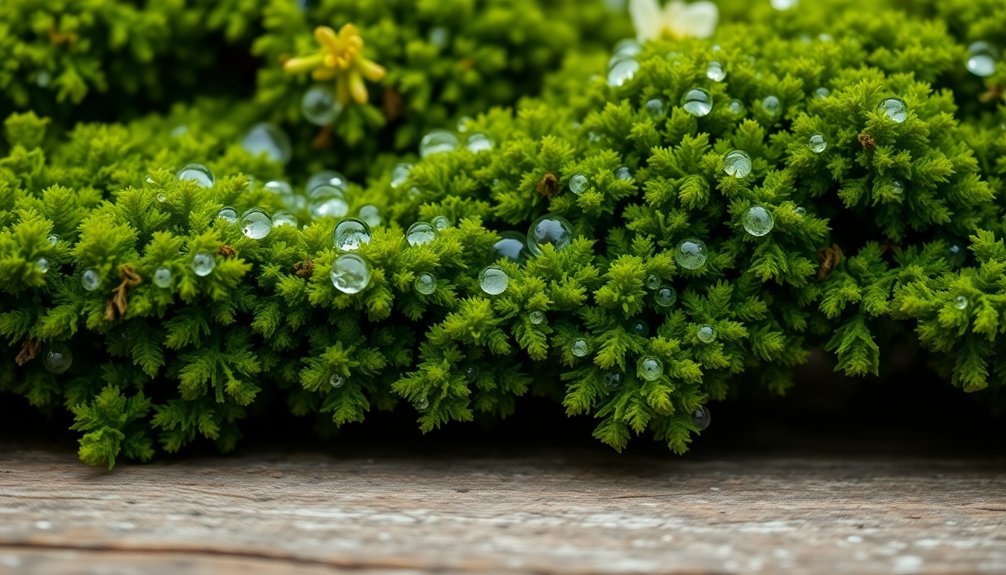
Since perfumers have sought to capture nature's essence in a bottle, oakmoss has stood out as one of the most distinctive and complex ingredients in natural perfumery. You'll discover an intricate aroma profile composed of roughly 80 distinct substances, creating a scent that's impossible to replicate synthetically. Chanel No. 5 and Shalimar showcase oakmoss's timeless appeal in iconic fragrances.
| Scent Aspect | Key Characteristics |
|---|---|
| Primary Notes | Earthy, mossy, woodsy |
| Secondary Notes | Musky, leathery, marine |
| Complementary Pairings | Bergamot, labdanum, lavender |
| Evolution | Smoky to honey-sweet |
| Fixative Properties | Enhances longevity, stabilizes blends |
When you work with oakmoss, you're tapping into a remarkable fixative that extends fragrance longevity while delivering an unmistakable forest-floor essence. It harmonizes beautifully with other natural oils like sandalwood and vetiver, making it indispensable in creating complex, long-lasting natural perfumes.
Essential Safety Guidelines for Working With Oakmoss
Working safely with oakmoss requires strict adherence to established safety protocols, as this potent natural ingredient can pose various health risks when mishandled.
When working with oakmoss, you'll need to wear splash-resistant safety glasses and chemical-resistant gloves. Verify your workspace is well-ventilated, using an exhaust fan if necessary.
Store your oakmoss materials away from heat sources, sunlight, and combustible materials in tightly sealed containers kept upright to prevent leakage.
You'll need to be especially cautious if you're pregnant, nursing, or have epilepsy, as oakmoss isn't recommended for these conditions.
Don't exceed the regulated concentration limit of 0.1%, as oakmoss can trigger allergic reactions. Keep it away from children under 2 years and avoid application on sensitive or damaged skin.
Always wash your hands thoroughly after handling.
Blending Oakmoss With Complementary Notes
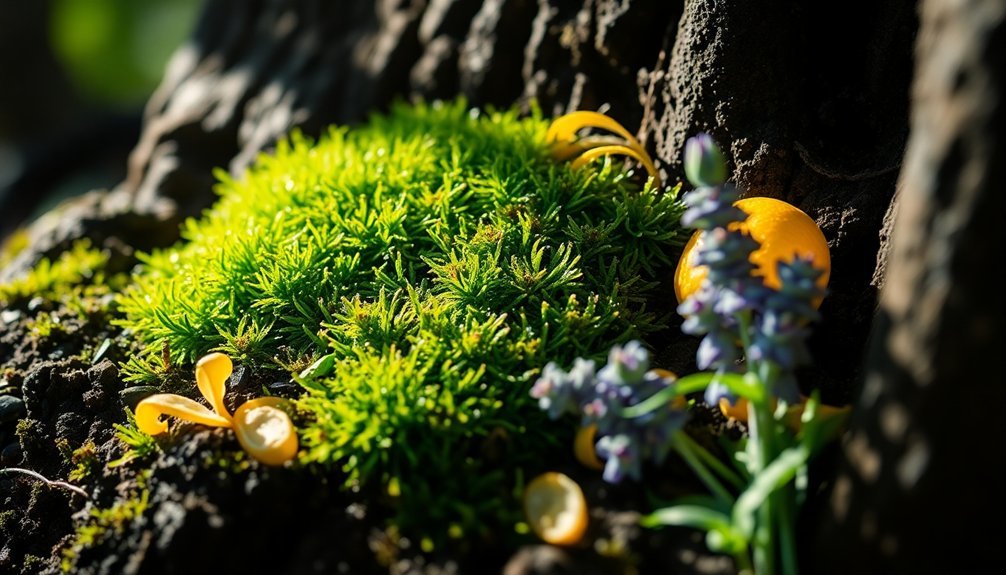
You'll discover that oakmoss pairs exceptionally well with bright citrus, delicate florals, and warm woods to create sophisticated fragrance compositions.
Working with oakmoss requires careful layering – start with small amounts and gradually build complexity by adding complementary notes like bergamot, jasmine, or cedarwood.
To achieve balance in your blends, counterpoint oakmoss's deep, earthy character with lighter notes while leveraging its natural fixative properties to anchor your creation.
Essential Oakmoss Pairing Notes
When creating natural perfumes with oakmoss, understanding its complementary pairings is essential for achieving balanced and sophisticated fragrances. You'll find that oakmoss works exceptionally well with citrus notes, creating classic chypre structures when paired with bergamot or adding vibrancy with lemon and orange.
| Note Family | Primary Pairings | Effect |
|---|---|---|
| Citrus | Bergamot, Yuzu | Fresh, Elegant |
| Floral | Jasmine, Rose | Rich, Complex |
| Woody | Cedarwood, Vetiver | Deep, Grounding |
For deeper compositions, you'll want to explore oakmoss's harmony with florals like jasmine and rose, which add complexity to the heart notes. The base can be enriched by combining oakmoss with woody notes like cedarwood or resinous materials such as frankincense. Don't forget its beautiful interplay with labdanum and vanilla for creating warm, sophisticated bases.
Creating Depth Through Layers
Building depth in oakmoss-based fragrances requires a thoughtful layering approach that maximizes the ingredient's versatile nature. Start with a bergamot or citrus top note, then gradually introduce floral elements like jasmine, rose, or iris to create a sophisticated heart.
You'll find that oakmoss naturally enhances these florals while extending their longevity on the skin. For a classic chypre structure, blend oakmoss with labdanum and patchouli in the base notes. This combination provides warmth and intensity that grounds the entire composition.
If you're aiming for a more masculine profile, pair oakmoss with cedarwood and amber, or incorporate it into a fougère structure with lavender and coumarin. Remember that oakmoss acts as both a fixative and enhancer, so you can use it to anchor your blend while adding complexity to the overall scent profile.
Balancing Light With Dark
Successfully balancing light and dark notes with oakmoss requires understanding its unique ability to bridge contrasting elements in perfumery. You'll find oakmoss excels at harmonizing with citrus, floral, woody, and resinous notes, creating sophisticated and long-lasting compositions.
| Note Family | Primary Benefits | Best Pairings |
|---|---|---|
| Citrus | Adds freshness & longevity | Bergamot, lemon |
| Floral | Creates depth & warmth | Jasmine, rose, iris |
| Woody/Herbal | Enhances earthiness | Cedar, lavender |
When working with oakmoss, start by pairing it with bergamot for a classic chypre structure. Then, layer in florals like jasmine or rose for complexity. You can further deepen the composition with woody notes like cedarwood or add warmth through amber accords. These combinations have stood the test of time in iconic fragrances like Mitsouko and Chanel No. 5.
Proper Storage and Handling Techniques
To preserve the delicate nature of oakmoss in natural perfumery, proper storage and handling techniques are crucial.
You'll need to store your oakmoss-based fragrances in a cool, dry environment away from direct sunlight and heat sources. A dark cabinet or drawer with stable temperature works best to prevent chemical degradation.
Always keep your bottles tightly sealed when not in use, as exposure to air can cause evaporation and alter the fragrance profile.
Don't leave caps off or store in open containers. UV rays can greatly damage oakmoss compositions, so use light-blocking storage solutions whenever possible.
Handle your bottles gently and avoid excessive shaking, which can disrupt the delicate layers of the perfume.
Remember to check expiration dates and rotate your stock to guarantee you're using older fragrances before they deteriorate.
Creating Your First Oakmoss Base Accord
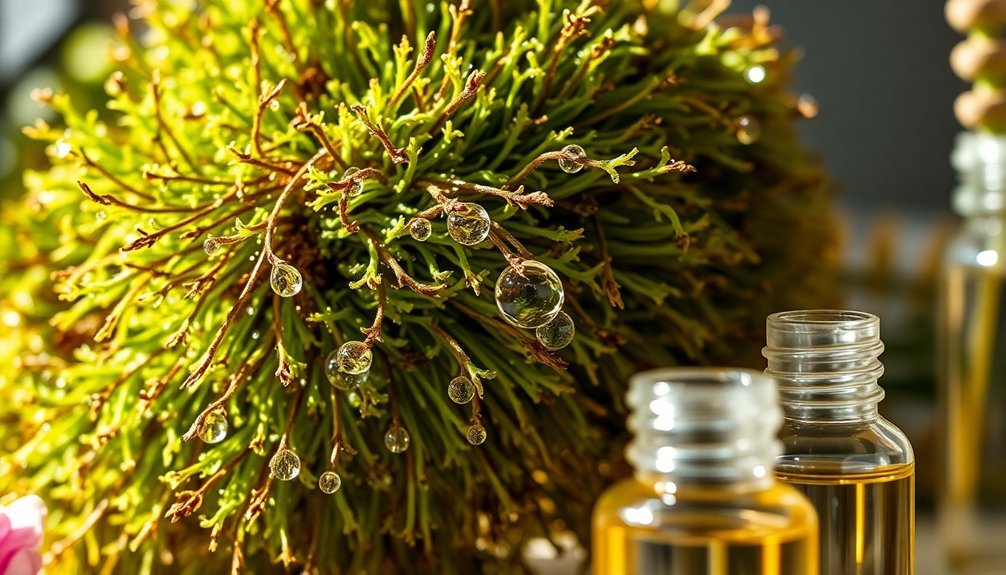
Now that you've mastered proper storage techniques, let's explore the creation of your first oakmoss base accord.
Start by combining oakmoss with complementary base notes like ambergris, vetiver, and patchouli. You'll want to carefully balance these ingredients to establish your foundation.
Next, add cistus labdanum and methyl ionones to enhance the accord's complexity. For stability and depth, incorporate small amounts of musk ketone and opoponax. These materials will help lock in your base notes while adding richness to the composition.
To soften the intensity and create a more approachable blend, introduce floral modifiers. Rose absolute works exceptionally well, but you can experiment with jasmine or carnation instead.
Finally, add a trace of civet if you're seeking a subtle animalic undertone to your accord.
Advanced Oakmoss Formulation Strategies
You'll discover that successful oakmoss formulations require precise blending ratios, typically starting with 1-2% oakmoss absolute in your base.
To enhance the fixative properties, you can combine oakmoss with benzyl alcohol or patchouli at a 3:1 ratio, which strengthens the foundation of your composition.
When working with treated oakmoss absolutes, you'll need to adjust these proportions based on HPLC analysis results to maintain regulatory compliance while preserving the desired olfactory profile.
Blending Ratios and Proportions
When crafting complex oakmoss-based perfumes, understanding precise blending ratios becomes essential for achieving a balanced and sophisticated fragrance. You'll want to start with a 55% base accord, incorporating oakmoss with complementary base notes like vetiver and musk at varying ratios (9:1, 8:2, 7:3). Test these combinations at 10% dilution to evaluate their synergy accurately.
| Ratio Type | Effect on Blend |
|---|---|
| Oakmoss Heavy (9:1) | Deep, earthy dominance |
| Balanced (7:3) | Harmonious depth |
| Light Touch (5:5) | Subtle foundation |
| With Musk (8:1:1) | Smooth complexity |
| Triple Blend (6:2:2) | Rich dimensionality |
Add your middle notes at 20% concentration, focusing on florals like jasmine or rose to soften the oakmoss's intensity. Finally, crown your creation with 25% top notes, carefully selecting citruses that'll enhance the oakmoss's natural characteristics.
Fixative Enhancement Techniques
Taking oakmoss's natural fixative properties to the next level requires mastering advanced enhancement techniques. You'll achieve superior results by pre-fixing your alcohol with resin tinctures and building layered accords that carry the fragrance through multiple stages of development.
When working with oakmoss, you can amplify its fixative power by combining it strategically with other botanical fixatives like orrisroot and vanilla.
Try pairing it with complementary resinoids such as myrrh and frankincense to enhance longevity, or experiment with animalic fixatives for complex, lasting accords.
You'll find that molecular distillation techniques help you harness oakmoss's essence while meeting IFRA standards.
For creative applications, don't hesitate to explore unique combinations with essential oils and botanicals, always maintaining balance and harmony in your final composition.
Regulatory Compliance and Usage Limits
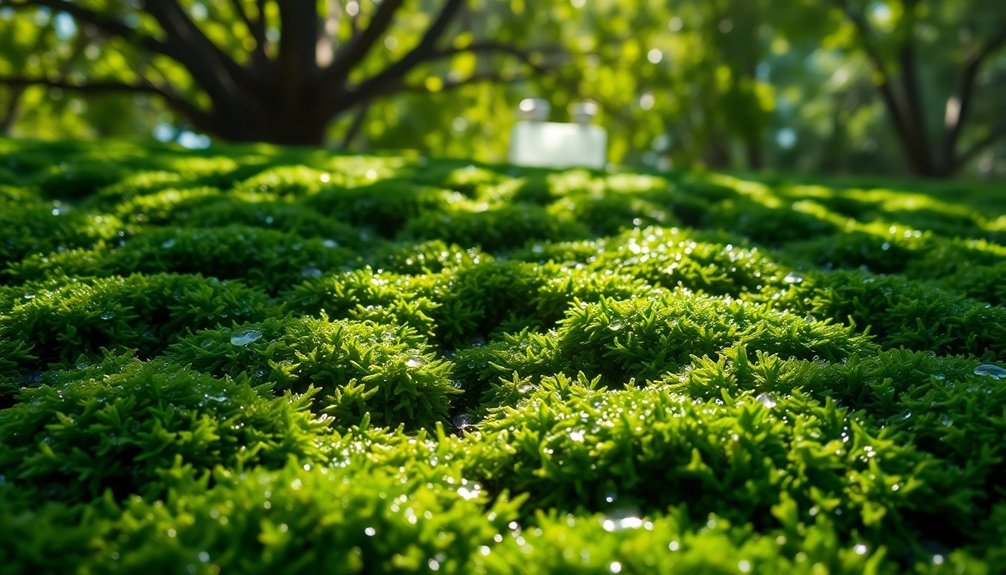
Due to growing concerns about skin sensitivities, oakmoss faces strict regulatory oversight in modern perfumery. The European Commission has banned atranol and chloroatranol, compounds found in oakmoss that can cause skin rashes in 1-3% of consumers.
To comply with IFRA standards, you'll need to guarantee your oakmoss contains less than 100 ppm of these allergens, achievable through fractional distillation. You're limited to using only 0.1% oakmoss in your finished perfumes.
Even with IFRA-compliant oakmoss available, many perfume houses are choosing synthetic alternatives like Evernyl.
You'll notice that many classic fragrances have been reformulated to meet these requirements. While you can still work with oakmoss, it's crucial to stay current with regulations and consider potential future restrictions in your formulations.
Sourcing Quality Oakmoss Materials
When you're sourcing pure oakmoss, look for suppliers like Payan Bertrand who maintain pre-IFRA quality standards and offer unadulterated green oakmoss products from traditional European forests.
You'll find the highest quality oakmoss comes from mountainous regions in France, the Balkans, and Morocco, where it grows naturally on oak, pine, and fir trees.
For sustainable harvesting practices, work with established suppliers who gather the material using traditional methods that have preserved these oakmoss populations for centuries.
Identifying Pure Oakmoss Sources
While obtaining pure oakmoss can be challenging in today's market, several reputable suppliers still offer this prized perfumery ingredient in its traditional form.
You'll find the highest quality oakmoss from Payan Bertrand, known for their unadulterated green products that closely match pre-IFRA standards. LMR offers excellent IFRA-compliant versions, though they lack some of the natural characteristics.
True oakmoss (*Evernia prunastri*) comes from pristine European forests, with the former Yugoslavia producing exceptional quality.
You'll recognize pure oakmoss absolute by its thick green paste consistency and remarkable 400-hour longevity on testing strips. Its rich, earthy scent profile combines woody and resinous notes with warm, sweet hay undertones.
While not IFRA-compliant due to atranol content, pure oakmoss remains legal in many regions.
Sustainable Harvesting Practices
Sustainable harvesting of oakmoss requires careful attention to both ecological preservation and quality control.
When sourcing this precious material, you'll want to verify your suppliers follow rotational harvesting practices in Central and Southern European oak forests, as well as North American locations.
Look for harvesters who remove only a portion of the lichen at a time, allowing for natural regrowth of this slow-growing species. They should work with local communities and maintain proper permits and tracking codes for their harvests.
Since oakmoss is crucial to many invertebrates, responsible collectors carefully preserve the surrounding ecosystem.
After harvest, the moss should undergo proper drying and preservation using natural methods.
You'll want to confirm that your supplier follows IFRA regulations and employs safe processing techniques to create high-quality absolutes and resinoids.
Oakmoss Alternatives and Substitutes
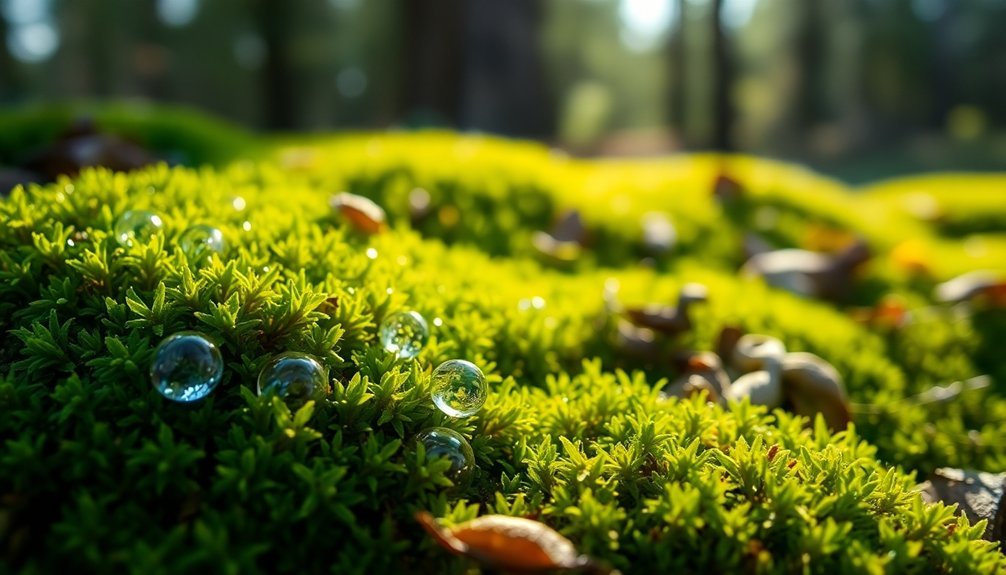
Due to regulatory restrictions on natural oakmoss, perfumers have developed several alternatives to replicate its distinctive earthy notes. You'll find both natural and synthetic substitutes in modern perfumery.
For natural alternatives, consider galbanum, which offers fresh, green notes, or Biolandes Moss, which closely mimics traditional oakmoss without harmful compounds.
While not direct substitutes, sandalwood and benzoin resin can enhance base notes and provide fixative properties.
In the synthetic domain, Evernyl (also known as Veramoss) stands as the most widely accepted alternative. It's often combined with other synthetics like Orcinyl 3 to achieve a more complex scent profile.
While these alternatives can't perfectly replicate natural oakmoss's richness, they're essential for creating contemporary fragrances that comply with IFRA guidelines.
Perfecting the Art of Oakmoss Dilution
Before working with oakmoss in natural perfumery, you'll need to master the essential skill of proper dilution.
Start by warming your oakmoss absolute in a hot water bath until it's easily workable. Use a clean pipette and tared bottle for precise measurements.
To create a 10% dilution, multiply your oakmoss weight by 9 to determine the solvent amount needed. For example, combine 0.66 grams of oakmoss with 5.94 grams of perfumer's alcohol. You can also use jojoba oil as an alternative solvent.
Once measured, mix the ingredients thoroughly for one minute, applying gentle heat if needed to aid dissolution.
After cooling, transfer your diluted oakmoss to a dark glass bottle and store it in a cool, dry place. Your diluted oakmoss is now ready for use in perfume blends.
Frequently Asked Questions
Can Oakmoss Essential Oil Be Produced Through Steam Distillation?
You can't effectively produce oakmoss essential oil through steam distillation, as the high temperatures would damage its sensitive compounds. You'll need to use traditional solvent extraction with ethanol or benzene instead.
Does the Age of the Oak Tree Affect Oakmoss Quality?
No, the age of the oak tree doesn't affect oakmoss quality. You'll find that extraction methods, growth environment, and the type of tree matter more in determining the absolute's quality and aromatic properties.
Why Do Some People Perceive Oakmoss Differently Than Others?
You'll perceive oakmoss differently due to your unique genetic makeup, personal experiences, and sensitivity to fragrances. Your cultural background and any allergic reactions can also shape how you interpret this complex scent.
How Does Altitude Affect the Chemical Composition of Wild Oakmoss?
At higher altitudes, you'll find oakmoss with different chemical concentrations because cooler temperatures and intense sunlight affect how the lichen produces compounds like atranorin, chloroatranorin, and evernic acid during growth.
Can Oakmoss Be Sustainably Cultivated in Controlled Environments?
You'll face significant challenges cultivating oakmoss in controlled environments. The lichen's complex symbiotic nature and specific forest microclimate requirements make sustainable indoor cultivation difficult, though not entirely impossible with advanced CEA technology.
In Summary
Working with oakmoss requires patience, skill, and careful attention to regulations. You'll find that mastering this complex ingredient opens up endless creative possibilities in natural perfumery. While restrictions have changed how you'll use oakmoss, its irreplaceable depth and character continue to make it worthwhile. Whether you're using authentic oakmoss or exploring modern alternatives, understanding this master note will elevate your perfume creations.




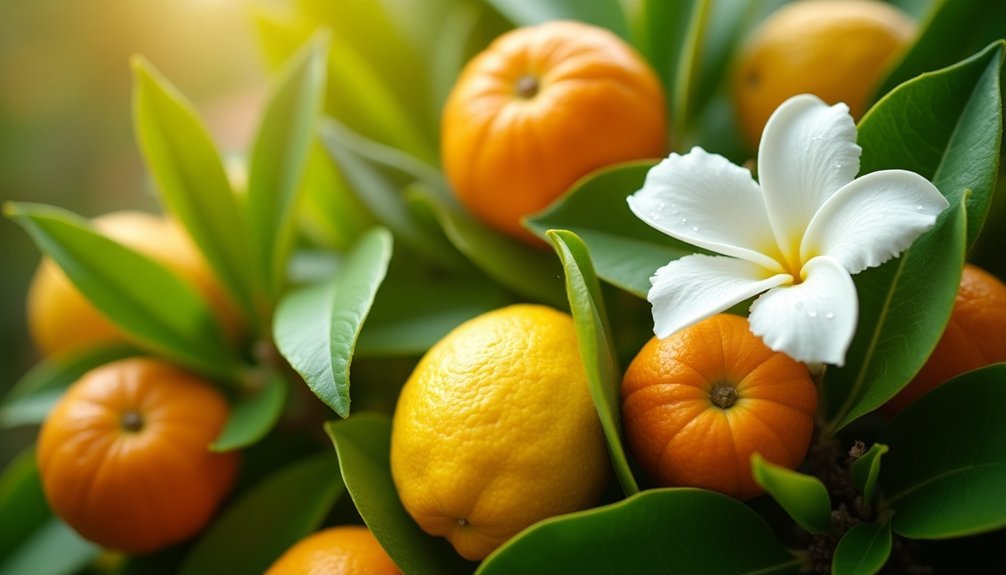
Leave a Reply